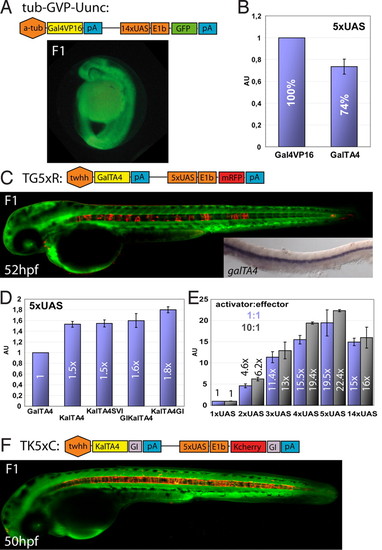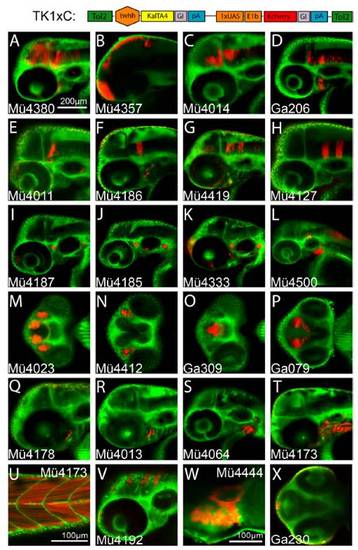- Title
-
Optimized Gal4 genetics for permanent gene expression mapping in zebrafish
- Authors
- Distel, M., Wullimann, M.F., and Köster, R.W.
- Source
- Full text @ Proc. Natl. Acad. Sci. USA
|
Optimization of the Gal4 system in zebrafish. (A) Schematic representation of construct tub-GVP-Uunc (10) and transgenic F1 zebrafish embryos. (B) Comparison of Gal4VP16 (set as 100%) and GalTA4 activity in luciferase assays (n = 3, Pac2 fibroblasts) using a 5xUAS:luciferase construct. (C) Schematic representation of the TG5xR construct and transgenic F1 embryo. Inset: mRNA in situ hybridization of GalTA4 expression throughout the notochord. (D) Activation potentials of differently modified Gal4 activators as determined by luciferase assays (n = 3). The activity of GalTA4 was set as 1. (E) Effects of different numbers of Gal4 DNA binding sites using pCSKalTA4GI and UAS-luciferase constructs (ratio 1:1 blue columns or 10:1 black columns) in luciferase assays (n = 3, 1xUAS:luciferase set as 1). (F) Schematic representation of the TK5xC construct and transgenic F1 embryo. Data are presented as mean ± SEM. Embryos in C and F are counterstained with green Bodipy Ceramide. |
|
KalTA4GI enhancer trapping. (A) Schematic representation of the TK1xC enhancer trapping construct. (B) Examples of transgenic Gal4 enhancer trap lines at 50 hpf (C) kalTA4 mRNA expression (asterisk: olfactory bulb, arrow olfactory epithelium) in line olf:KalTA4. (D) Transactivation of lynGFP in Ulyn (10) injected olf:KalTA4 embryo. (E) KalTA4-mediated transactivation of GFP expression in offspring (26 hpf) from crosses of heterozygous olf:KalTA4 and 4xUAS-KGFPGI carriers. (F) Different expression patterns in F1 embryos (50 hpf, lateral view) derived from the same P0 founder fish. (G) Offspring of a rh3/5:KalTA4 homozygous carrier crossed to a wild-type fish. Note that all embryos display the characteristic mCherry fluorescence in rhombomeres 3 and 5. Embryos in B and F are counterstained with green Bodipy Ceramide. |
|
Maintenance of rhombomeres 3/5 labeling in Kaloop fish. (A–E) Expression of GFP in rhombomeres 3/5 in offspring from a cross between rh3/5:KalTA4 and 4xUAS-KGFPGI or (F-J) rh3/5:KalTA4 and 4xKaloop carriers (schematic representation of effector constructs shown). (A–C, F–H) Expression of mCherry and transactivated GFP at 26 hpf. (D) At 11 hpf, GFP fluorescence (red ovals) is diminished in 4xUAS-KGFP carriers and (E) lost in the adult brain, while in 4xKaloop carriers (I, J) it is maintained in 2 clusters in the hindbrain until adulthood (white arrows). (E, J) Sagittal sections at 100 μm, abbr.: see Fig. 4. |
|
Rh3/5-Kalooping identifies the secondary octaval nucleus (SON) as rhombomere 5-derived. Immunhistochemistry for GFP (green) and Cholinacetyltransferase (ChAT; red) on brain vibratome sections of adult zebrafish derived from crosses of (A) rh3/5:KalTA4 × 4xKGFP and (B–F) rh3/5:KalTA4 × 4xKaloop. All nuclei were counterstained with DAPI (blue). (A and B) Sagittal sections of the hindbrain. (C) Transverse section through the caudal GFP-expressing hindbrain region (r5) in B. (midline marked by dashed line). (D) Sagittal section (rostral is left) showing GFP-positive dendrites in the crista cerebellaris (white arrow). (E) Axons of GFP-positive neurons project through the midbrain into the (F) torus semicircularis. Note typical periventricular cholinergic cells in optic tectum. Abbr.: cb: corpus cerebelli, cc: crista cerebellaris, llf: lateral longitudinal fascicle, nVI: rostral and caudal abducens nuclei, OEN: octavolateralis efferent neurons, r: rhombomere, SGVN: secondary gustatory/viscerosensory nucleus, ts: torus semicircularis, tec: optic tectum, va: valvula cerebelli. |
|
Transgenic zebrafish KalTA4 enhancer trap strains. A schematic representation of the trapping construct TK1xC is shown at the top of the figure. (A–X) Confocal microscopy images of Bodipy ceramide-counterstained (green) embryos from isolated KalTA4 enhancer trap lines. Embryos were screened for tissue-specific mCherry fluorescence (red) between 24 and 36 hpf; images were recorded at approximately 50 hpf using a Zeiss LSM510 and a 20x objective. (A–L, Q–T, and U–W) lateral views (W 6dpf heart), (M–P) ventral views and (X) dorsal view. For detailed description of expression patterns see the database at: http://www.helmholtz-muenchen.de/en/idg/groups/neuroimaging/lines_distel/. EXPRESSION / LABELING:
|
|
Analysis of isolated zebrafish KalTA4 enhancer trap strains. (A) Numbers of independent transgenic founders in the P0, F1, and F2 generation of the KalTA4 enhancer trap screen. (B) Screenshot of searchable database in which images of different expression patterns from many strains are displayed. In addition, sequences of the respective Gal4-activator and UAS effector vectors as well as a protocol for nested inverse PCR to determine the integration sites of the enhancer trap vector in different lines can be found at: http://www.helmholtz-muenchen.de/en/idg/groups/neuroimaging/lines_distel/. (C>) Distribution of expression patterns in the isolated tissue specific KalTA4 enhancer trap lines of the F2 generation. (D) Distribution of all observed expression patterns throughout the isolated KalTA4 strains of the F2 generation. Note that many lines show mCherry expression in several tissues. Distel |
|
Comparative mRNA in situ hybridization analysis to determine the onset of expression in rhombomeres 3 and 5 of (A–C) egr2b in WT embryos, (D–F) kalTA4 and (G–I) gfp in offspring of rh3/5:KalTA4 X 4xKGFP cross. (J–L) mRNA in situ hybridization analysis of downregulation of expression of kalTA4 and (M–O) gfp in rhombomeres 3 and 5 of rh3/5:KalTA4 X 4xKGFP embryos. Arrows indicate expression domains of the respective genes. |
|
Retrograde labeling of secondary octaval nucleus (SON) neurons. Adult brain cryostat sections (100 μm) of rhodamine dextran injected adult rh3/5:KalTA4 X 4xKaloop fish. (A) Rhodamine dextran (red) injection site in the central nucleus of the torus semicirculars (TS). The arrow demarcates the site where the tectum was removed. (B) Rhodamine dextran (red) positive axons innervate the TS coming from caudal projection nuclei and (C, enlarged area of B marked with yellow square) some are positive for GFP expression (white arrow). (D) Rhodamine dextran-positive axons are derived from hindbrain neurons, (E) they cross the midline at the level of r3 and r5 and (F) turn dorsally (G–I, enlarged area of F marked with yellow square) revealing their origin from GFP-expressing somata of rh3/5:KalTA4 X 4xKaloop labeled neurons. Abbr.: llf: lateral longitudinal fascicle, r: rhombomere, TS: torus semicircularis. |








